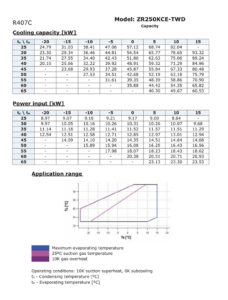Chiller or refrigerator
Chillers are thermal machines that employ the compression and expansion phases of particular gases, allowing to steal heat from a fluid.
These are machines in a proper sense, that require a series of components to operate:
- Compressor
- Condenser
- Evaporator
They so combine a machine with heat exchangers.
Here we’re gonna talk generically about water refrigerators, which are chillers that use a vapor compression cycle of a refrigerant gas (freon, ammonia) in order to cool water (producing refrigerated water) to be employed for cooling purposes in a production process.
These machines therefore include a refrigerating section and an hydraulic section for the storage and circulation of the refrigerated water.
I’ve just wrote here above ‘producing refrigerated water’, which is clearly an ‘error’ because in fact what happens here is that chillers cool water by absorbing heat, reducing therefore their temperature.
There are two main families of chillers, depending on the condensing fluid employed:
- Water cooled
- Air cooled
In fact, water cooled (condensed) chillers employ a water exchanger to condense the refrigerant gas, while the second ones employ air. The latter are more noisy and energy consuming, but are water consumption-free.
In order to better understand some applications of chillers, it’s important to comprehend that the performance of a chiller, in other words the chiller cooling capacity expressed in KW (or in Kcal/h), mainly depends upon two important factors:
- Output required temperature of the water (temperature/evaporation pressure)
- Ambient temperature (temperature/condensation pressure)
1. Essentially, the more the required output temperature of the water goes down, the more the thermal efficiency of a chiller decreases. In other words, a chiller that has to dissipate a given amount of thermal energy ‘producing’ water at a higher temperature will have a lower energy consumption than a chiller which has to dissipate the same amount of thermal energy but obtaining water at a lower temperature. An example: 100.000 Kcal/h of water at 5° C are more expensive than 100.000 Kcal/h at 15° C.
2. A chiller has a better performance when working at low ambient temperatures (within determined limits), compared to an installation in a warmer environment.
To better explain, here below there is a scheme of the performance of a chiller compressor, calculated upon variations in evaporation and condensation temperatures.
This info must always be considered when designing cooling systems, because chillers consume energy, and they consume more energy when working at limit conditions of ambient and cooled fluid temperatures.
When a project is being developed, this limits must be determined at first, in order to properly size the cooling system upon the right operating conditions.
It’s always better to over-size the passive elements of the system, heat exchangers for example. A functioning chiller is indeed consuming power every operating minute/hour/day/month, while a bigger heat exchanger represents a cost only in the first investment step.




 Back to index
Back to index Download the complete book
Download the complete book